
The Scorpaeniformes are a diverse order of ray-finned fish, including the lionfishes and sculpins, but have also been called the Scleroparei. It is one of the five largest orders of bony fishes by number of species, with over 1,320.
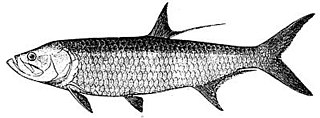
The Elopiformes are the order of ray-finned fish including the tarpons, tenpounders, and ladyfish, as well as a number of extinct types. They have a long fossil record, easily distinguished from other fishes by the presence of an additional set of bones in the throat.
The Notacanthiformes are an order of deep-sea ray-finned fishes, consisting of the families Halosauridae and Notacanthidae.
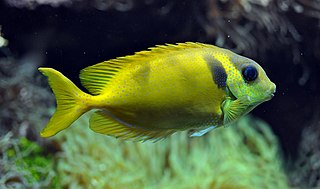
Neopterygii is a subclass of ray-finned fish (Actinopterygii). Neopterygii includes the Holostei and the Teleostei, of which the latter comprise the vast majority of extant fishes, and over half of all living vertebrate species. While living holosteans include only freshwater taxa, teleosts are diverse in both freshwater and marine environments. Many new species of teleosts are scientifically described each year.

The Congridae are the family of conger and garden eels. Congers are valuable and often large food fishes, while garden eels live in colonies, all protruding from the sea floor after the manner of plants in a garden. The family includes over 220 species in 32 genera.

The Carangidae are a family of ray-finned fish that includes the jacks, pompanos, jack mackerels, runners, trevallies, and scads. It is the largest of the six families included within the order Carangiformes. Some authorities classify it as the only family within that order but molecular and anatomical studies indicate that there is a close relationship between this family and the five former Perciform families which make up the Carangiformes.

Ophichthidae is a family of fish in the order Anguilliformes, commonly known as the snake eels. The term "Ophichthidae" comes from Greek ophis ("serpent") and ichthys ("fish"). Snake eels are also burrowing eels. They are named for their physical appearance, as they have long, cylindrical, snake-like bodies. This family is found worldwide in tropical to warm temperate waters. They inhabit a wide range of habitats, from coastal shallows and even rivers, to depths below 800 m (2,600 ft). Most species are bottom dwellers, hiding in mud or sand to capture their prey of crustaceans and small fish, but some are pelagic.

The Elopidae are a family of ray-finned fish containing a single living genus Elops. They are commonly known as ladyfish, skipjacks, jack-rashes, or tenpounders.
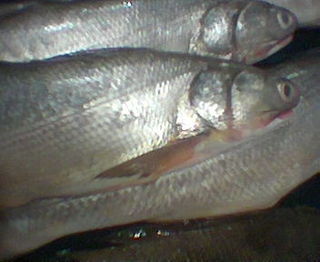
Elops machnata, the tenpounder, is a species of ray-finned fish in the family Elopidae in the order Elopiformes. This species is found in coastal regions of the Indian Ocean.
Anguilloidei is a suborder of ray-finned fishes belonging to the order Anguilliformes, the eels.

Albulidae is a family of fish, commonly known as the bonefishes, that are popular as game fish in Florida, select locations in the South Pacific and the Bahamas and elsewhere. The family is small, with 11 species in 3 genera. Presently, the bonefishes are in their own order: Albuliformes. The families Halosauridae and Notacanthidae were previously classified in this order, but are now, according to FishBase, given their own order Notacanthiformes. The largest bonefish caught in the Western Hemisphere is a 16-pound, 3 ounce example caught off Islamorada, Florida, on March 19, 2007.

The Chlopsidae, or false morays, are a family of marine ray-finned fishes belonging to the order Anguilliformes, the eels. The eels in this family arefound in coral reefs worldwide. As their name suggests, they somewhat resemble moray eels in appearance. However, they are smaller than true morays, ranging from 11 to 42 cm in length.

Eels are ray-finned fish belonging to the order Anguilliformes, which consists of eight suborders, 20 families, 164 genera, and about 1000 species. Eels undergo considerable development from the early larval stage to the eventual adult stage and are usually predators.

Cynoponticus is a genus of marine ray-fiined fishes belonging to the family Muraenesocidae, the pike congers. The fishes in this genus are found in the Eastern and Western Atlantic Oceans and the Eastern Pacific Ocean, with a single parapatric species in each region.

Ophichthus is a genus of eels in the snake eel family Ophichthidae.

Myrophinae, the worm eels, is a subfamily of ray-finned fishes belonging to the family Ophichthidae, which also includes the snake eels in the subfamily Ophichthinae.

Congroidei is a suborder of ray-finned fishes belonging to the order Anguilliformes, the eels. These eels are mostly marine, although a few species of snake eel will enter freshwater, and they are found in tropical and tempareate waters throughout the world.
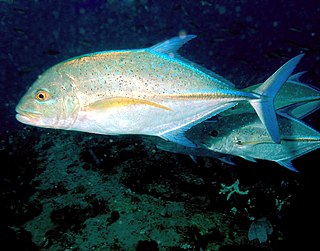
Carangiformes is an order of ray-finned fishes that is part of a sister clade to the Ovalentaria, the other orders in the clade being the Synbranchiformes, Anabantiformes, Istiophoriformes, and Pleuronectiformes. The Carangiformes have been long regarded as a monotypic order with only the family Carangidae within it by some authorities, and the other current families within the order have been previously classified as part of the wider order Perciformes. The 5th edition of Fishes of the World classify six families within Carangiformes, with other authorities expanding the order to include up to 30 families.
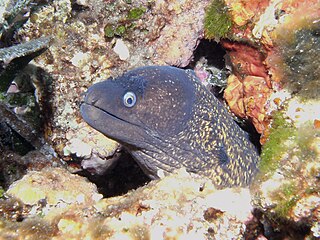
Muraenoidei is a suborder of mainly marine ray-finned fishes belonging to the order Anguilliformes, the eels. The eels in this suborder are distributed in the tropical and temperate seas around the world.



















